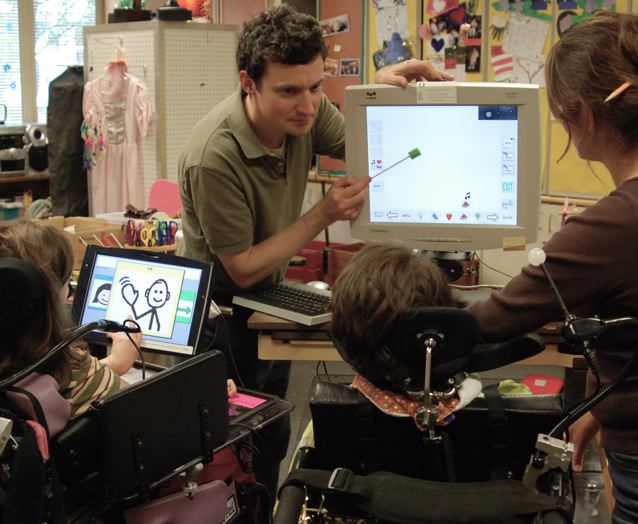
An NSF-funded research project underway in the Department of Computer and Information Science at the University of Oregon, with Associate Professor Anthony Hornof as the principle investigator (researcher).

In this photo, Associate Professor Anthony Hornof is working with two girls with severe motor impairments and an assistive technologies (AT) specialist at a home for children with severe disabilities. Dr. Hornof and the AT specialist are working with the initial challenge of explaining to a young woman with severe cerebral palsy (and thus extremely limited experience controlling physical objects) how her eye movements can be used to make things happen on a computer screen.
In this project, Dr. Hornof is collaborating with children with severe motor impairments and their caregivers in the design of eye-controlled software that will enable these children to express themselves creatively. One such system developed thus far is EyeDraw, software that enables people with severe motor impairments to draw pictures by just moving their eyes.
A recent highlight of the project (in 2007) was an eleven-week ethnographic study that Dr. Hornof conducted at a home for children with severe disabilities. The study was aimed at working within existing frameworks for social interaction with the children to learn about the lives of these children and their caregivers. One of the most interesting outcomes of the study is a realization that, when working with children with severe disabilities, caregivers must continually face situations in which they really have no idea what is on a child's mind, or what a child might be trying to communicate. To work with this population, designers and researchers will need to cope with strong feelings of unknowing and awkwardness.
Specific insights with respect to collaborating with these children to develop eye-controlled software include (a) the need to incorporate basic communication and caregiver assessment opportunities throughout any interface for this population, (b) collaborative roles for stakeholders such as siblings and parents, and (c) the need for low-tech non-electronic communication to develop higher-tech communication devices, even if it is just a researcher learning a child's behavior when they want to stop an activity.
National Science Foundation IIS-0713688. $449,319 for 7/15/07 to 6/30/10. Principal Investigator (PI): Anthony Hornof. Title: HCC: Easy-to-Learn and Easy-to-Use Eye-Controlled Musical Expression For Children with Severe Disabilities.
National Science Foundation IIS-0553117. $140,052 for 12/1/05 to 5/31/07. PI: Anthony Hornof. Title: SGER: Collaborating with Children with Severe Disabilities in the Design of Eye-Controlled Software.
This material is based upon work supported by the National Science Foundation (NSF) under the above grants. Any opinions, findings and conclusions or recomendations expressed in this material are those of the author(s) and do not necessarily reflect the views of the NSF.
Last updated: ajh, 11/28/07